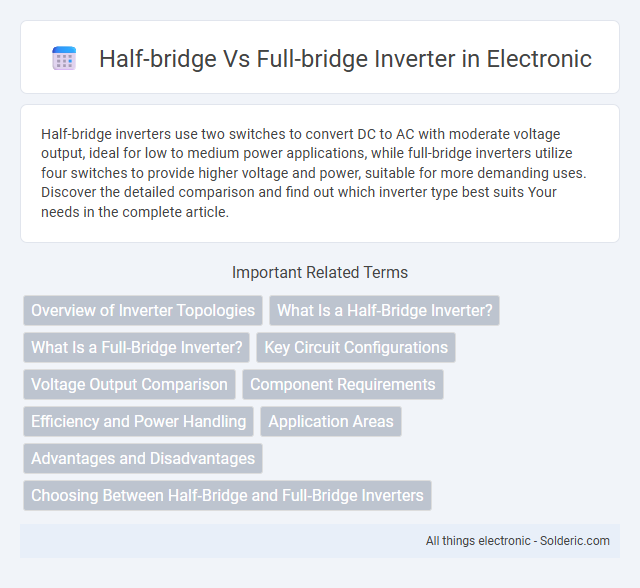Half-bridge inverters use two switches to convert DC to AC with moderate voltage output, ideal for low to medium power applications, while full-bridge inverters utilize four switches to provide higher voltage and power, suitable for more demanding uses. Discover the detailed comparison and find out which inverter type best suits Your needs in the complete article.
Comparison Table
| Feature | Half-Bridge Inverter | Full-Bridge Inverter |
|---|---|---|
| Topology | Two switches, split DC source | Four switches, single or split DC source |
| Voltage Output | Half of DC voltage | Full DC voltage |
| Power Rating | Medium power applications | High power applications |
| Complexity | Simple circuit design | More complex control and circuitry |
| Switching Devices | 2 switches (IGBTs or MOSFETs) | 4 switches (IGBTs or MOSFETs) |
| Output Waveform | Less sinusoidal quality | Better sinusoidal output |
| Efficiency | Lower efficiency due to voltage clamping | Higher efficiency and voltage utilization |
| Applications | Small UPS, low-power drives | Industrial drives, renewable energy inverters |
Overview of Inverter Topologies
Half-bridge and full-bridge inverters are fundamental topologies used to convert DC into AC power with distinct configurations and performance characteristics. A half-bridge inverter employs two switches and two capacitors, offering a simpler design suitable for lower power applications and reduced voltage stress on components. Full-bridge inverters utilize four switches to provide higher output voltage and improved efficiency, making them ideal for medium to high power applications and enabling better control over the output waveform for your power conversion needs.
What Is a Half-Bridge Inverter?
A half-bridge inverter is an electronic circuit that converts DC voltage into AC voltage using two switches and a midpoint connection to split the input voltage. It provides an output waveform that alternates between positive and negative half cycles, utilizing capacitors to divide the DC supply voltage. Half-bridge inverters are commonly used in applications requiring moderate power levels and simpler control circuitry compared to full-bridge inverters.
What Is a Full-Bridge Inverter?
A full-bridge inverter uses four switching devices arranged in an H-bridge configuration to convert DC into AC, providing a complete waveform output with both positive and negative cycles. This design enables higher output voltage and improved efficiency compared to a half-bridge inverter, which only uses two switches and produces a narrower voltage range. Your choice between half-bridge and full-bridge inverters depends on the required power level, output waveform quality, and application complexity.
Key Circuit Configurations
Half-bridge inverters feature two switches and two capacitors arranged to split the DC voltage into two equal halves, creating a midpoint that serves as a reference for output voltage waveform generation. Full-bridge inverters utilize four switches configured in an H-bridge topology, allowing the output voltage to invert polarity and provide higher output voltage levels than half-bridge designs. The half-bridge topology is simpler and uses fewer components, while the full-bridge topology offers improved voltage utilization and better control over output waveform quality.
Voltage Output Comparison
Full-bridge inverters provide a higher voltage output by utilizing four switching devices that allow the load voltage to swing both positive and negative, producing a voltage nearly double that of the half-bridge inverter. Half-bridge inverters use only two switches and capacitors to split the DC input voltage, resulting in an output voltage that is approximately half the input DC voltage. Your choice between the two impacts the effectiveness of voltage output in applications requiring higher or more stable power delivery.
Component Requirements
A half-bridge inverter requires fewer components, typically using two switches and two capacitors, which reduces cost and circuit complexity. Full-bridge inverters demand four switches to enable full voltage output and bidirectional current flow, offering higher power efficiency and control. Your choice depends on whether simplicity or enhanced performance is the priority in your power conversion application.
Efficiency and Power Handling
Half-bridge inverters typically offer lower efficiency and reduced power handling capabilities compared to full-bridge inverters due to their simpler design and fewer switching devices. Full-bridge inverters provide higher power output and improved efficiency since they utilize both halves of the DC supply, allowing for better voltage utilization and reduced harmonic distortion. Optimizing your choice between half-bridge and full-bridge inverters depends on the specific efficiency requirements and power demands of your application.
Application Areas
Half-bridge inverters are commonly used in low- to medium-power applications such as uninterruptible power supplies (UPS), simple motor drives, and residential solar power systems due to their cost-effectiveness and simpler design. Full-bridge inverters are preferred in high-power applications like industrial motor drives, electric vehicle propulsion, and large-scale renewable energy systems because they provide better power output, higher efficiency, and improved waveform quality. The choice between half-bridge and full-bridge inverter depends on the required power level, efficiency, and complexity of the application.
Advantages and Disadvantages
Half-bridge inverters offer simpler circuitry and lower component costs, making them ideal for low-power applications, but they suffer from reduced output voltage and higher harmonic distortion compared to full-bridge inverters. Full-bridge inverters provide higher output voltage and better waveform quality due to their ability to utilize both halves of the power cycle, making them suitable for high-power, industrial applications. However, full-bridge configurations involve increased complexity and higher component costs, which can impact system size and maintenance requirements.
Choosing Between Half-Bridge and Full-Bridge Inverters
Choosing between half-bridge and full-bridge inverters depends on your power requirements and application complexity. Half-bridge inverters are ideal for low to medium power applications, offering a simpler design with fewer components and lower cost. Full-bridge inverters provide higher efficiency and better output waveform quality, making them suitable for high-power systems and scenarios demanding full control of output voltage polarity.
half-bridge vs full-bridge inverter Infographic

 solderic.com
solderic.com